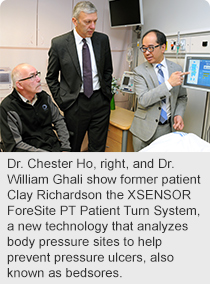
May 8, 2015
Story by Colin Zak; photo by Paul Rotzinger
When Clay Richardson first developed a pressure ulcer, he thought he was coming down with the flu.
“I had a fever and chills, so I asked my daughter to bring me to the hospital,” says Richardson, who became paraplegic after a car accident in March 2014.
“It wasn’t until I got to the hospital that my doctors told me I had a pressure sore.”
 For Richardson, it meant surgery and five months in hospital.
For Richardson, it meant surgery and five months in hospital.
But he isn’t alone.
Pressure ulcers, also known as bedsores, are common in patients who spend extended periods of time in bed or sitting down – and researchers at Foothills Medical Centre (FMC) are trying to change that.
A randomized controlled trial now underway is looking at the effectiveness of a new technology – EXSENSOR’s ForeSite PT Patient Turn System. A thin, flexible mattress overlay goes underneath the sheet on a patient’s bed and is designed to help reduce the risk of pressure ulcers in hospital patients. The study is the only one of its kind in the country.
“Pressure ulcers can cause pain, decrease quality of life, and lead to significant complications and prolonged hospital stays,” says Dr. Chester Ho, co-lead for the study, Section Head of Physical Medicine and Rehabilitation in the Department of Clinical Neurosciences with Alberta Health Services (AHS) and the University of Calgary.
“The device will allow us to examine the effectiveness of this new system in relieving pressure and preventing pressure ulcers.”
The University of Calgary’s Ward of the 21st Century (W21C) is now conducting an independent evaluation of the technology in five different hospital wards at FMC. More than 200 AHS nurses and other hospital staff at have been trained to use the new system, and W21C researchers aim to enroll 670 patients in the study.
Pressure ulcers are one of the most common complications in hospital, and can cost the health system millions each year. Pressure ulcers are estimated to occur in about one-quarter of all hospital patients in Canada.
They are caused by continued compression of skin by the weight of the individual. This impairs blood circulation, which in turn damages the skin’s integrity and results in a chronic wound. Pressure ulcers are most common among individuals who are immobile and spend extended periods of time in the same position.
“Bedsores are much more serious than many would expect,” says Richardson.
“Mine went nearly to the bone.”
The XSENSOR device monitors, records, and analyzes persistent body surface pressures – a key factor in the risk of developing pressure ulcers – and provides this information on a display above the bedside. This new technology was designed to help health care providers know if and when a patient needs to be turned.
The study compares two groups of subjects: those in the intervention group and those in the control group. Patients in the intervention group will have the sensor mat over their mattress for pressure sensing, and they also have the real-time feedback by the monitor available for viewing. However, the control group will only have the sensor mat on top of their mattress, without the real-time feedback by the monitor.
The study will examine whether there is a difference in the patient-turning strategy by the health care providers, when they have real-time feedback on their patients’ pressure status compared with those who do not have the feedback.
“The ForeSite PT TM system provides visual, easy-to-understand pressure images by identifying areas that are experiencing elevated pressures,” says Dr. William Ghali, a professor in the Cumming School of Medicine, co-lead for the W21C Program and Scientific Director for the O’Brien Institute for Public Health, and one of the lead investigators for the study.
“This technology could provide clinicians and other health care providers with the information they need to strategically shift patients when and where needed, and minimize those pressures before ulcers develop.”
For Richardson, it is research that is much-needed.
“Pressure ulcers are often avoidable,” he says. “A device like this one that will help health care staff know where there’s pressure so they can move patients just makes sense.”